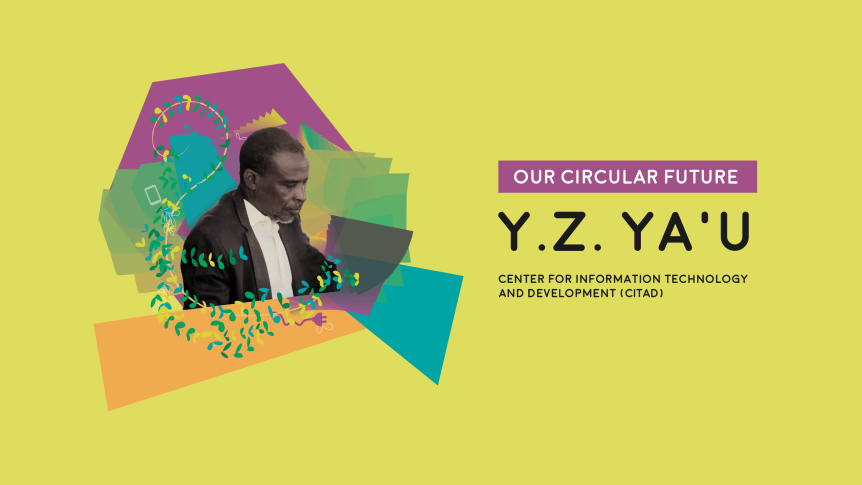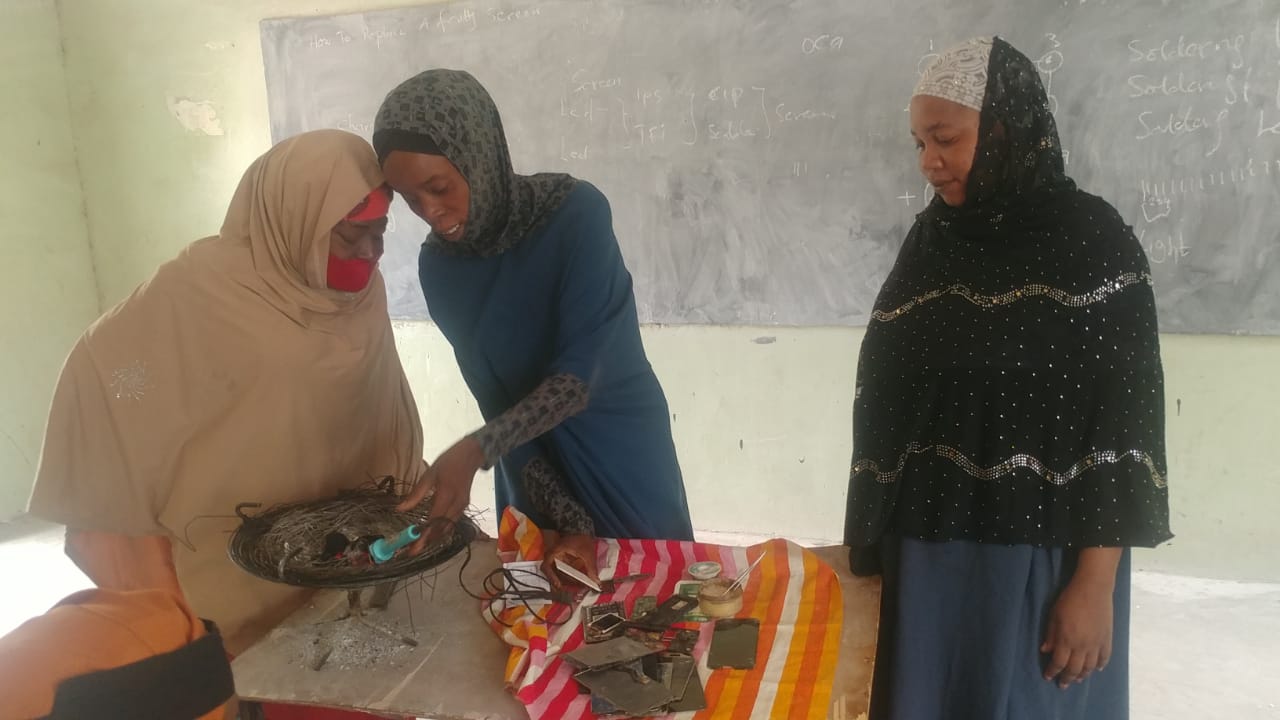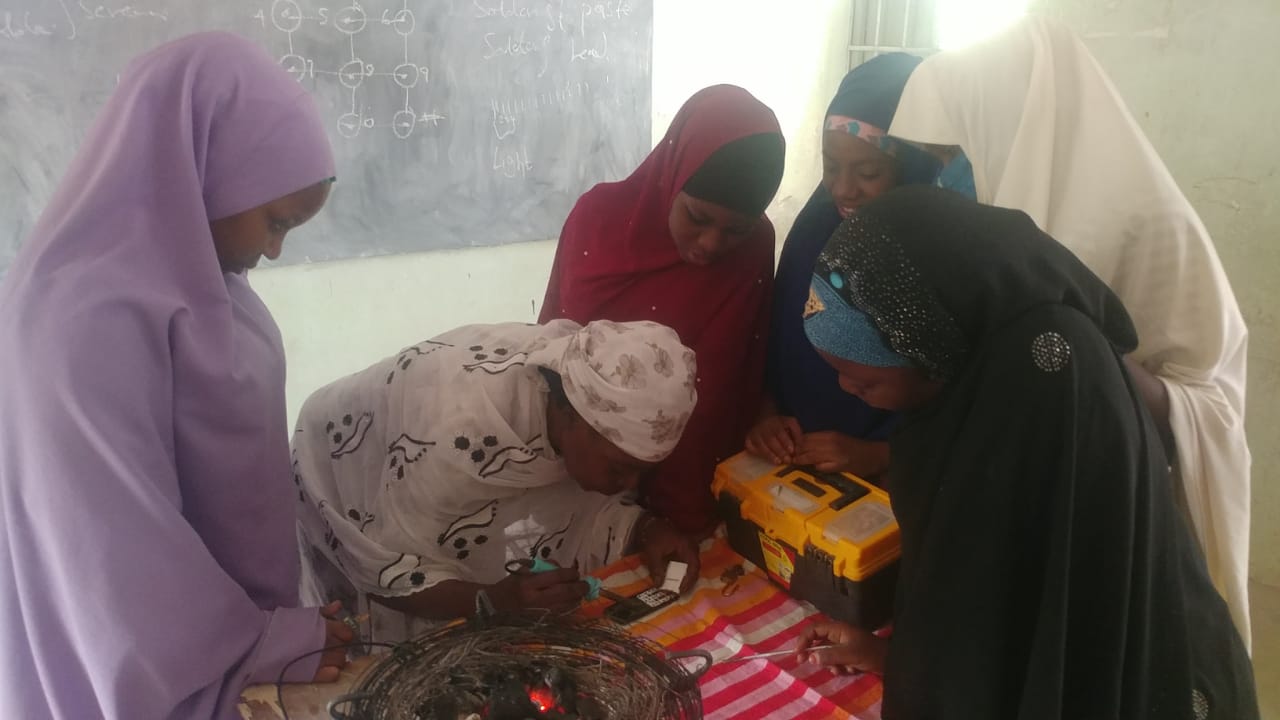
“A circular economy is a declaration of interdependence," states APC's Guide to the circular economy of digital devices. "My computer or phone or any digital device is not just mine, it is ours. Someone else could have used it before me, or could use it after me. It depends on and affects nature.” This circularity is key to making digital devices sustainable, as explored through research and powerful case studies presented in the guide.
In this first part of a new series, we are reconnecting with APC network members who contributed to the guide, this time about their vision for Our Circular Future regarding information and communications technologies (ICTs). We spoke with Y. Z. Ya’u, executive director of the Centre for Information Technology and Development (CITAD) in Nigeria, about lessons learned and the changes needed to keep advocating for the right to repair movement, which puts power in the hands of consumers to fix their own tech instead of encouraging the replacement of devices.
This interview has been edited for clarity and length.
In your 2021 case study on mobile handset repairs in Nigeria, you talked about some successes and challenges with the process. How have circumstances changed since then? Have conditions improved or worsened?
There are two changes that I have noticed. One came from discussions with a number of women-led groups. They expressed that they find it difficult to give their handsets to the regular repairers in the designated markets precisely because of feeling there is a lack of privacy. You give your handset to somebody you don't know, they work on it and possibly break into your passwords. Perhaps it is better to train more women who can work within neighbourhoods where they know each other. There’s an element of trust when you know someone personally compared with going to a market where the relationship is determined by the market and nothing else. There is the issue of gender and inclusion in the sense that if you allow men to dominate the repair sector, it means first of all that women will not be able to get the skills to repair handsets, but more importantly, many of the women will not want to give their own handsets to be repaired. They would prefer women like them to be able to repair their handset for them.
When we did that research, it wasn’t something that we were aware of or took into consideration. Of course we did notice that the people who are undergoing the trainings were predominantly men, but we had not considered the gender implications, especially in the context of privacy and digital inclusion. This is something that has come up since.

The second thing was not too clear or too obvious but I think is something that is beginning to emerge. I think that major companies like Philips electronics, which have set up repair units for handsets, have done so targeting high-end users – people with expensive handsets and so forth. Our suspicion is that they also want to control the repair and reuse sector, and so they are testing the high-end markets where it would be profitable for them to repair expensive handsets. I think they could then gradually find a way to perhaps use this power to demand certain certification processes for people to be allowed to engage in repair and reuse activities. We think it's something that we have to watch out for and see how bigger companies could move into this sector and what impact it would have in the future.
What are some emerging new themes in the right to repair movement?
We would probably take three things into account. The first is that at CITAD we have started training women at the neighbourhood level. We are looking at the challenges women face in terms of learning and also with securing market access when they have the skills. Then in terms of access to components, we are examining where they get the things that they replace, and how easily they can access components, including in terms of price and availability.
The second would be to follow up on the bigger companies and see how they are coming in and what sort of policy implications that has. Are they going to leverage this power to get governments to create policies around the repair and reuse sector that would favour them? Would their entry allow them to control access to components that ordinary repairers require for repairs? Are they going to build linkages and direct relationships with primary producers of components for the repairs?
The third area is one we have started at CITAD at a smaller level. In dealing with the huge problem of e-waste, what can you extract out of handsets and use for other purposes, not just for repairing them but for producing other products? One of the things that our team has been doing is taking out the cameras and using them to produce CCTV systems for our own office and for other people. We are not dismantling CCTVs, we are dismantling the handsets and then taking bits of them to produce CCTV systems. We are also using them for lamps in case the power goes off. Those are the sorts of things we are experimenting with at the moment. We feel there is potential to support the means of livelihood for ordinary people, that’s one aspect, but also the extent to which they may be able to reduce the volume of e-waste we see in the community.
What would you like to see in newer guides on the circular economy?
The APC guide has been very useful and we have given it to quite a number of people to see what they can learn from it. I’d like to see a guide that goes beyond telling people about the issues and problems, but also what skills they can acquire to deal with e-waste and to practice repair and reuse and other forms of circular economy with respect to the ICT sector. I would like to see more of a training guide in addition to the guide we have. I think that people would also want to move from knowing about issues and subjects to knowing how to deal with them on a daily basis.

How do you see the future of circular economies developing in your country or region?
It requires a crystal ball to see the future, but it’s a very complex dynamic in the sense that issues are becoming clearer. More and more people and governments are talking about the need for sustainability. The only direction for that is the circular economy, but I think that industrial production and management are still leaning toward linear economic models. They are also dominating thinking within governments. The challenge is, how do you gather enough strength to be able to turn around the thinking, both in government and among the major players on the scene, to begin to change from linear models to circular economy models? I think that requires a lot of work, a lot of advocacy, a lot of community organising and also a lot of research to demonstrate the unworkability of the current models that we’re using.
We need to do a lot of research to show alternative models, and that the alternatives are working. Research is not just about choosing either the circular or the linear models; I think we have to go both ways. On the one hand, we need to show that linear models are becoming unsustainable in the current world and that there are alternatives in the circular models. But we also need organisers and people to speak out on the need to shift from linear models to circularity. That means more public engagement and more policy making to shift thinking within governments and industry to begin to take action, to push for a circular economy in various aspects of work in different sectors. This applies whether we are considering energy usage or the extraction of resources for the production of ICT tools and devices.
What is the one piece of advice you’d give to an organisation starting to engage with technology and the circular economy?
My advice would be nuanced by the location of the organisation, because the counterarguments used in making people think that we either do not have options or that in spite of it all, the world is safe, are different and location-specific. If the organisation is from the global South, where the digital divide is still huge, I suggest that they should avoid the trap of the false binary and false argument that we first need to eliminate the digital divide before we begin to worry about carbon emissions from ICT systems. Both governments that do not want to do anything with the challenge and the corporate world that profits from it are driving arguments that developing countries should focus on eliminating the digital gap, after which they can then begin to worry about the impact of ICT systems on the climate.
Such organisations also need to work with ordinary people, especially in places where poverty makes it difficult to acquire ICT goods and people therefore have to rely on imported second-hand ICT goods, whose life span is extremely small. In addition, these second-hand ICT goods are already e-waste, thus contributing to the accumulation of e-waste in developing countries, where there is very poor capacity for recycling and management of waste.
In both the global North and global South, we should focus more on the fact that linear models of production and consumption are doing great harm to the environment, inducing serious climatic changes that portend grave consequences for humanity. We should therefore work to understand how that is happening and what can be done to get out of the cozy trap of linearity by embracing circular models of production and consumption. We must see the problem of the impact of ICTs on the environment not as resulting from some isolated activities, but as a core consequence of the specific choices we made that found an easy embrace in extractivism, based on a linear consumption pattern. The current models of extraction and use of resources – whether in the ICT sector or generally in the industrial global production system – are not sustainable. The bottom line is to understand that linearity and growth will not go together.
Our Circular Future series
- In this new series, we reconnect with members who contributed to our guide on the circular economy of digital devices, this time about their vision for the future of these economies. In part one, we speak with CITAD about what is needed in the right to repair movement, emerging trends and lessons learned and missed. Read: “The bottom line is to understand that linearity and growth will not go together”: Introducing Our Circular Future, a series on the future of circular economies
- In part two of this special series, we spoke with Florencia Roveri at our Argentina-based member Nodo TAU. From supporting youth with future e-waste projects to exploring the challenges to electronic waste treatment, Nodo TAU has been advocating for better ICT recycling practices in the community. Read: Our Circular Future: “Our strength comes from addressing multiple needs like the environment, youth employment and using technology for social use”
- In this third part of our special series on Our Circular Future, Syed Kazi of Digital Empowerment Foundation (DEF) in India talks to us about how one of the highest-consuming regions of the world needs to urgently adopt circular economy approaches across all sectors. Read: Our Circular Future: "We must adopt the circular economy without waiting for the government to say, ‘Hey, this is a time bomb now'"
- In this fourth part of the series on Our Circular Future, Colnodo’s Plácido Silva tells us about good and bad electronic waste management practices in Colombia and their impact on education. Read: Our Circular Future: "We don’t want to see the circular economy become a new marketing campaign"
- In the fifth part of Our Circular Future series, Leandro Navarro from Barcelona-based APC member Pangea explores ways to build mobile phones that are socially and environmentally responsible as well as how principles of reuse are essential for social inclusion. Read: Our Circular Future: "If you're reading this, you’re part of the environmental problem"
Further reading: APC's Guide to the circular economy of digital devices describes the concepts and processes of circularity and summarises the key challenges and opportunities, including for policy advocacy.